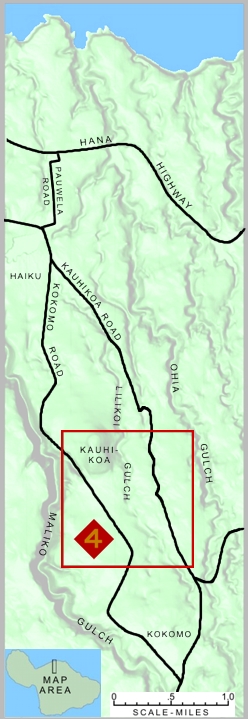
© 2009, Alvin F. Kanda
MAP SHOWING LOCATION OF CAMP MAUI |
At the outbreak of WWII, the U.S. Army rented 1,600 acres from various landowners in the Haiku area. The principal owners were: Hawaiian Pineapple Co. (490 acres), Maui Agricultural Co. (397 acres) and the Copp Estate (220 acres). Thirteen different owners accounted for the remaining 493 acres. The rental for the site was $15,000 per year, prorated among the owners.
In November 1943 the acreage was transferred to the U.S. Marine Corps. The 48th Navy Construction Battalion (Seabees) began construction of a 20,000-man camp. Wooden framed 16 ft. x 16 ft. tents were constructed for living quarters as well as larger tents for mess halls. Quonset huts were constructed for galleys, ordnance and shops. Based on an aerial photograph, the camp structures were between Maliko Gulch on the west, Ohia Gulch on the east, Kauhikoa hill on the north and Kokomo town on the south (area enclosed in red on map). This area accounts for only about 880 acres. The balance of of about 720 acres were training areas. Adjacent to the camp was a demolitions area, grenade area, pistol range and machine-gun range. On the north shore was a rifle range at Opana Point. Further east was a moving-target bazooka range and a range that allowed armored vehicles and infantry to practice coordinated firing.
The camp was first occupied by the 4th Marine Division in late February 1944 after the Roi-Namur operation in the Marshall Islands. In mid-May the Division left Kahului Harbor for maneuvers in Maalaea Bay and then headed for the Saipan invasion via Pearl Harbor and Eniwetok. After the Saipan battle, the Division took part in the Tinian battle which ended in July. The Division arrived back on Maui from the Saipan-Tinian operation in late August 1944. In late February 1945 the Division left Kahului Harbor for maneuvers in Maalaea Bay and Kahoolawe and headed for the invasion of
|

